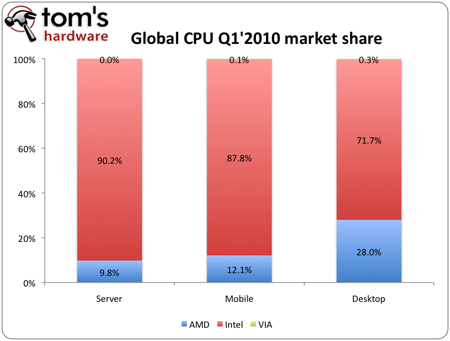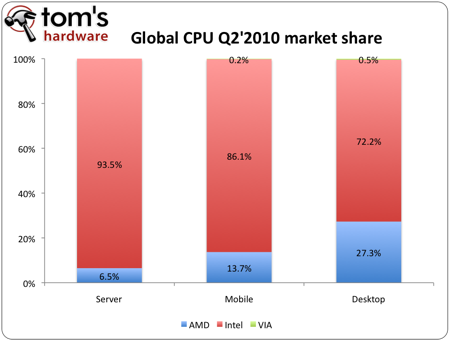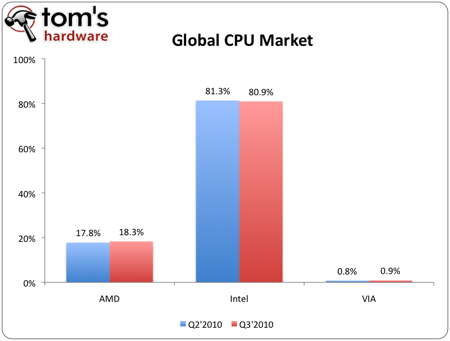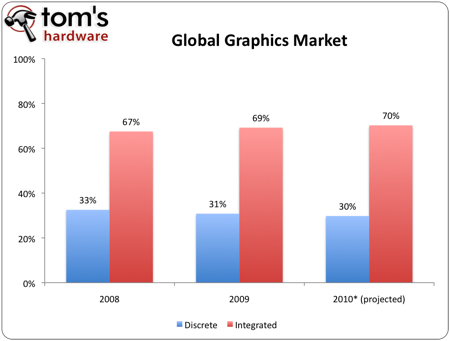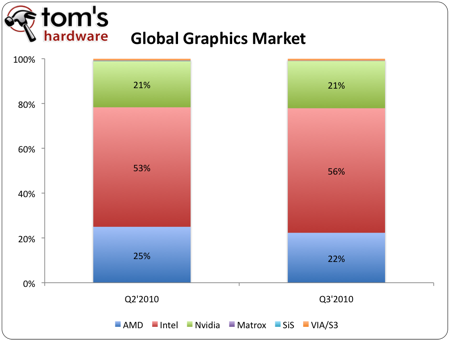AMD Fusion: Brazos Gets Previewed: Part 1
The AMD And Intel Tug Of War
According to recent Q3 market share numbers, the perpetual back and forth between AMD and Intel is once again in a state of flux. The larger company is taking substantial chunks of away from AMD in the high-end server market, thanks mostly to the Xeon family's transition to Nehalem-based designs in the 1P, 2P, and MP segments. And we do mean huge, as AMD’s overall server market share fell from ~10% to 6.5% (source: IDC). The Opteron 6000-series is holding its own, but it really isn’t putting up a good enough of a fight to retain its foothold.
This reinforces our belief that the Magny-Cours-based server processors only serve as a temporary placeholder. That product line is meant to hold Intel back until Bulldozer becomes available. This isn’t necessarily a bad strategy, as Q3 was the 4th consecutive quarter that we saw the price paid per CPU rise (Oct. 27th report from Mercury Research), which only helps to advocate AMD’s lower price points.
AMD is doing better in the desktop world, which makes up the largest portion of its CPU portfolio. Comparatively, Intel has a much beefier portion of the notebook market. However, all three market segments have seen some of the slowest per quarter growth (1.9% for Q3), less than a third of the historical numbers. Server sales still outrank desktop, while mobile CPU numbers fall to third place. This disproportionate growth is why AMD saw some mild gains in Q3, as the company's larger desktop CPU foothold helped shore up revenue lost to a slowdown in the mobile market.
Source: IDC, Jon Peddie, Mercury, Intel
Why does this all this matter? We’ve covered much of this information in our manager surveys, but Intel and AMD are both about to throw monkey wrenches into the graphics battle, too. The two companies are on the cusp of unveiling new processor platforms that feature integrated graphics technology. In September, we saw Sandy Bridge at IDF, which will put CPU and graphics processing on a single piece of silicon etched at 32 nm. It is definitely exciting stuff. But Intel's solution is, ironically, facing the unlikely underdog position, as very few industry veterans have much faith in the company's ability to deliver even mediocre graphics capabilities. Moreover, it is keeping the architecture's fixed-function media encoder close to its chest. Very few folks have seen it in action.
Meanwhile on October 19th, AMD showed off its upcoming Llano APU (Accelerated Processing Unit--the company’s acronym for a CPU/GPU hybrid).
In general, the real divider for the graphics industry isn't integrated versus discrete. What separates the proverbial men from the boys is performance. It’s the reason every gamer worth his salt cringes when you stick him with an IGP-based platform. Performance is the very reason people complain about high bit rate HD video playback on low-end systems like netbooks.
Get Tom's Hardware's best news and in-depth reviews, straight to your inbox.
Historically, IGPs have never approached the low-end discrete space. There's just too much of a power/heat difference between something you stick under a passive heatsink the size of a postage stamp soldered onto a motherboard and the real estate available on even a single-slot add-in card. As a result, those two markets are as divided as oil and water. Intel’s Sandy Bridge architecture and AMD’s Fusion initiative are about bringing in the tide that'll blur this line in the sand.
Remember, Intel has a bigger portion of the graphics pie, thanks to its northbridge-based integrated graphics solutions and more recent HD Graphics engine, built onto the Clarkdale and Arrandale CPUs.
That leaves AMD and Nvidia to duke it out in the discrete graphics space, while Intel watches from its cushy vantage point, not really needing a competitive offering. Even when we were dealing with front-side bus-hobbled CPUs, Intel could always outmode Nvidia, AMD, SiS, and VIA chipsets in sheer sales thanks to price and compatibility. System vendors could always trust an Intel CPU paired to an Intel chipset. This isn’t to say that third-party chipsets didn’t work. However, they often required extra effort on the part of the ODM or OEM. As they say, when you have a problem, it's always better to have one throat to choke.
As we start working with more proprietary interconnects like DMI and UMI, Intel and AMD can both deny Nvidia the ability to sell its own compatible chipsets. Particularly now that we no longer need a separate northbridge, the integrated graphics fight is going to be purely AMD versus Intel--that is, until the Delaware courts tell Nvidia otherwise or VIA achieves more than a 1% market share.
As far as graphics performance goes, it's fair to say that Intel has a lot more to prove with Sandy Bridge than AMD does with the upcoming designs in its Fusion program, if only because of the expertise introduced by ATI. Of course, we'll spend more time with Sandy Bridge soon, but today is AMD’s 2010 Financial Analyst day, and so we can finally spill a few beans on what Fusion will mean in the months and years to come.
-
bombat1994 awesome to see amd get into the netbook centre, finally show the public how badly the atom is clock for clockReply -
Interesting to see them projecting an increased market in netbooks given all the high profile remarks about Tablets supposedly cannibalizing it.Reply
-
acku Tablets get us into a whole other portion of the debate, as we need to start also talk about demographics. The short version of the conversation - keep in mind that a cannibalized market doesn't necessarily mean a decrease in the volume. It generally translates into a slow down in growth and a smaller proportional market.Reply
Cheers,
Andrew Ku
TomsHardware.com -
joytech22 AMD has and always will kick Intel's ass in the IGP market (excuse the rude but necessary language)Reply
Well, at least that's what i think, probably going to get downed a bit. -
compton The more the merrier. My hope is that AMD can leverage this launch into a successful campaign, then bring more competitive desktop solutions to people like me, looking at my Phenom II, then looking at the Intel 32nm core i3 that can meet or beat it... and gets worse from there. If Brazos doesn't do so hot, AMD's gonna need some serious tricks (like a miracle) to bring the heat to Intel. My Phenom II is pretty good stacked against the Core 2 but its almost 2011. Bring the funk AMD! Or let me know if you decide to... well, not. I'm ready for it now.Reply -
dEAne While AMD cannot go straight with intel in big CPU battles he makes little ones like david to bite it's toes to make intel preoccupied until bulldozer arrives.Reply -
super_tycoon Trust me, I've tried playing dirt2 on a ultra-thin and you get miso soup for graphics. A kind of foggy, blurry slurry; it's not something you really want to be associated with.Reply -
SteelCity1981 If the Graphics Core is based on the Evergreen architecture then why not just call it Radeon 5250 and 5310 series? It's just confusing to the consumor standpoint to call a Radeon GPU a 6250 and a 6310 when it's based on the Radeon 5 series. Especially considering there will be no new Radeon 6 series that will come out lower then the 6800 series.Reply -
lunyone Let's see my wishlist in a netbook or equivalent:Reply
* Decent battery life (if needed for plane trips) *possibly??
* Around 15" screen (I like this size, 10" seems too small for me) *possibly??
* Be able to play HD (whether online or off a DVD) *sounds like a good possibly??
* Be able to play most recent games on (even low settings is fine) *possibly??
*
